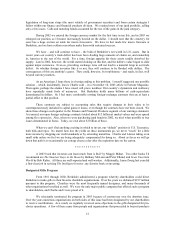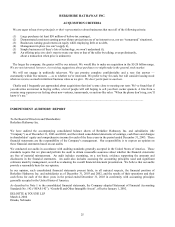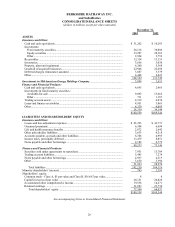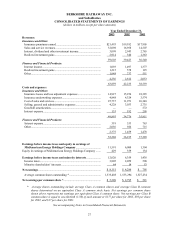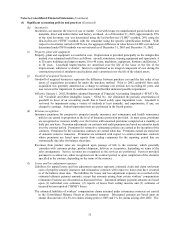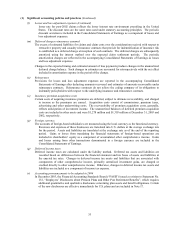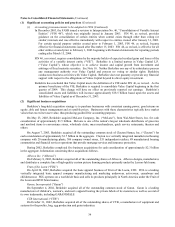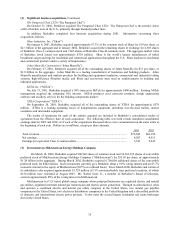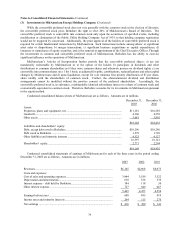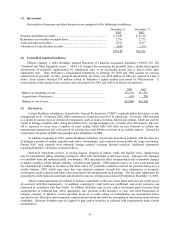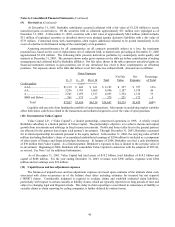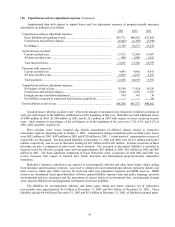Berkshire Hathaway 2003 Annual Report Download - page 32
Download and view the complete annual report
Please find page 32 of the 2003 Berkshire Hathaway annual report below. You can navigate through the pages in the report by either clicking on the pages listed below, or by using the keyword search tool below to find specific information within the annual report.31
(1) Significant accounting policies and practices (Continued)
(d) Investments (Continued)
judgement, the decline in value is other-than-temporary, the cost of the investment is written down to
fair value with a corresponding charge to earnings. Factors considered in determining whether an
impairment exists include: the financial condition, business prospects and creditworthiness of the issuer,
the length of time that the asset’ s fair value has been less than cost, and Berkshire’ s ability and intent to
hold such investments until the fair value recovers.
Berkshire utilizes the equity method of accounting with respect to investments where it exercises significant
influence, but not control, over the policies of the investee. A voting interest of at least 20% and no
greater than 50% is normally a prerequisite for utilizing the equity method. However Berkshire may
apply the equity method with less than 20% voting interests based upon the facts and circumstances
including representation on the Board of Directors, contractual veto or approval rights, participation in
policy making processes and the existence or absence of other significant owners. Berkshire applies the
equity method to investments in common stock and investments in preferred stock when such preferred
stock possesses substantially identical subordinated interests to common stock. Berkshire accounts for
investments in unconsolidated limited partnerships under the equity method.
In applying the equity method, investments are recorded at cost and subsequently increased or decreased by
the proportionate share of net earnings or losses of the investee. Berkshire also records its proportionate
share of other comprehensive income items of the investee as a component of its comprehensive income.
Dividends or other equity distributions are recorded as a reduction of the investment. In the event that
net losses of the investee have reduced the equity method investment to zero, additional net losses may
be recorded if additional investments in the investee are at-risk, even if Berkshire has not committed to
provide financial support to the investee. Berkshire bases such additional equity method loss amounts, if
any, on the change in its claim on the investee’ s book value.
(e) Loans and finance receivables
Loans and finance receivables consist of commercial and consumer loans originated or purchased by
Berkshire’ s finance and financial products businesses. Loans and finance receivables are carried at
amortized cost.
(f) Derivatives
Derivative contracts are predominantly used to manage economic risks associated with financial
instruments of finance and financial products businesses, including other derivative contracts. In
addition, Berkshire enters into derivative contracts to manage general economic risks of the Company as
a whole. Derivative instruments include interest rate, currency and equity swaps and options, interest
rate caps and floors, futures and forward contracts and foreign currency exchange contracts.
Berkshire carries all derivative contracts at estimated fair value. These contracts are classified as trading
account assets or trading account liabilities in the accompanying Consolidated Balance Sheets and
reflect reductions permitted under master netting agreements with counterparties. The fair values of
these instruments represent the present value of expected future cash flows under the contract, which is
a function of underlying interest rates, currency rates, security values, related volatility, the
creditworthiness of counterparties and duration of the contract. Future changes in these factors or a
combination thereof may affect the fair value of these instruments. Most derivative contracts entered
into by Berkshire are not designated as hedges for accounting purposes. Realized and unrealized gains
and losses from such contracts are included in the Consolidated Statements of Earnings.
(g) Securities sold under agreements to repurchase
Securities sold under agreements to repurchase are accounted for as collateralized borrowings and are
recorded at the contractual repurchase amounts.


